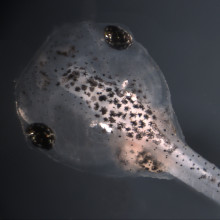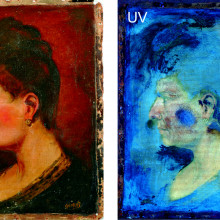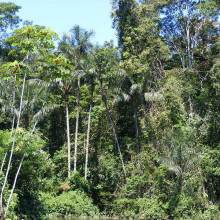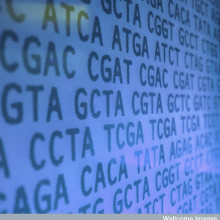This week, we hear how the first amphibian genome helps to fill the vertebrate family tree, meet the colourful fish that shine a light on evolution and find out how a technique developed to study eye disease can help find art forgeries. Plus, the genome from a clinical perspective - we look at the future of personalised medicine.
In this episode

00:15 - The First Amphibian Genome – A Genetic Leap Forward
The First Amphibian Genome – A Genetic Leap Forward
An analysis of the genome of the Western Clawed Frog, Xenopus tropicalis was published in the journal Science this week, marking the very first amphibian genome sequenced.
Uffe Hellsten and colleagues at the Department of Energy Joint Genome Institute in Walnut Creek, report the finding that nearly 80% of genes associated with human diseases have their counterpart in the frog's genome - which has roughly the same number of protein coding genes as our own.
 The western clawed frog is particularly interesting for a number of reasons. Firstly, being the first amphibian to be sequenced it helps us to understand the full range of vertebrate genes - we've already got the rat, chicken, zebra fish and human genome, so we're filling a gap in the vertebrate family tree.
The western clawed frog is particularly interesting for a number of reasons. Firstly, being the first amphibian to be sequenced it helps us to understand the full range of vertebrate genes - we've already got the rat, chicken, zebra fish and human genome, so we're filling a gap in the vertebrate family tree.
Also, the world's amphibians are under threat at the moment, with populations in serious decline. This genome may help to understand some of the problems that amphibians currently face, and so give us clues as to how to prevent further losses.
But the western clawed frog is more than just an example the class Amphibia - it's of particular interest to us because it's biologically similar to it's cousin, the African clawed frog or Xenopus laevis. The African clawed frog has been vital to our understanding of embryology since it was used for pregnancy testing back in the 40s. It has large, sturdy and easily manipulated eggs, and so it, and it's smaller relative the western clawed frog, rapidly became some of the most popular organisms in embryology.
The frog's genome is remarkably similar to that of the chicken or our own in basic structure, for example, frog genes have very similar neighbours compare with human genes about 90% of the time. We last shared a common ancestor with frogs around 360 million years ago, but there are around 1700 genes in the frog genome that are very similar to disease-related human genes.
Frogs are known to produce their own antibiotic compounds, to help keep their moist skin free from infection, and some of the genes responsible for this have already been identified.
The researchers were surprised to see a very large proportion of mobile genetic elements, called transposons - accounting for about one third of the genome. These generally don't code for a protein, but are involved in controlling the way the genes work, including reorganising genes in the chromosomes. It will take more research to discover the real implications of this.
This discovery will create new ways to look at human development and disease, as well as act as a scaffolding for sequencing the larger X. laevis genome. It will also help in the process of chromosomal archaeology - allowing us to piece together the story of vertebrate chromosomes, and how they developed into the incredible variety of species we see today.

03:32 - Colourful fish shed light on ocean evolution
Colourful fish shed light on ocean evolution
A group of colourful fish living on Caribbean coral reefs have shed light on how species evolve in the oceans.
The seas brim with thousands of species but how they evolved remains something of a conundrum. Now researchers from the University of East Anglia, in the UK, and Simon Frazer University in Canada, have uncovered evidence suggesting fish can separate into new species without a geographical barrier - a rarity in the fluid, underwater world. With the help of hundreds of volunteer divers spotting fish in REEF surveys (Reef Environmental Education Foundation), the research team tracked the location of hamlet fish, from the genus Hypoplectrus, all across the Caribbean. 
These are small fish, around 15cm or 6 inches long, that come in a variety of colours including yellow, blue and black (one of my favourites is the indigo hamlet - a deep indigo colour with white bands that look like it's been tie dyed). Previously, it was thought that marine species might have evolved during times when the sea level was lower which split populations into separate water bodies. These subdivided populations would then have given rise to new species. This new study, published in the journal Global Ecology and Biogeography, revealed that hamlet species tend to live in a series of clusters or hotspots. If species evolved in isolation, we might expect to see separate hotspots for different species: the evolutionary cauldrons of the past. But instead, many species live in more than one hotspot and individual species hotspots overlap, suggesting that hamlets didn't evolve separately but in the same areas.
It could be that other factors like competing for food and habitat are more important than geographical isolation in the story of how the hamlets evolved into different species. Now researchers need to work out what is controlling the current distribution of hamlets and uncover what is stopping them from interbreeding and blurring species boundaries.
This study has put good scientific use to data collected by amateur scuba divers and the findings have provided at least part of the solution to the riddle of how some species in the oceans have evolved, and continue to do so.

06:35 - Helping you to see Fake Art
Helping you to see Fake Art
A technique developed to take three dimensional, real time images of the retina is also useful for detecting evidence of fraud in paintings, according to research published in the journal Accounts of Chemical Research this month.
Piotr Targowski and colleagues at Nicolaus Copernicus Univeristy in Torun, Poland, realised that the technique of Optical Coherence Tomography, or OCT, should be able to image the layers of a painting, just as it does in biological tissue such as the retina.
 |
| The oil painting on the left fluoresces when exposed to ultraviolet light (right), but evidence of signature forgery remained unseen until a new non-invasive imaging technique was used. © Waldemar Grzesik, Institute for the Study, Restoration and Conservation of Cultural Heritage, Nicolaus Copernicus University |
OCT can be thought of as the light version of ultrasound. A beam of light, usually at near infra-red wavelengths, is sent into a tissue, and the reflected light is collected. Much of the light is scattered, and so will not produce an image, but OCT filters this scattered light to produce an image much like ultrasound. It can produce a high resolution, three dimensional, real time image, though it doesn't penetrate very deeply into the tissue.
Paintings are, usually, built up in layers. The very back of the painting will be the canvas itself, but the artist will often apply a layer of adhesive to this, to make sure future layers stick properly. You may then get a primer layer, an outine, various layers of coloured paint, or semitransparent glaze, and then a protective varnish. Clearly, each layer will be incredibly thin, but this is where the high resolution of OCT comes into it's own.
It's important for conservation purposes to understand the stratigraphy of a painting, and the most common way to do this is to cut a sample of the paining away, embed it in resin and observe it under a microscope.
OCT allows you do image all of the layers without even touching the painting, down to the micrometer level.
Yes. By imaging all of the layers on a painting, you can easily see where something has been painted over, or added at a later date. An example given in the paper is of a painting of St Leonard, a Franciscan monk in painted in 1797. The painting bears the inscription "St Leonard" in one corner, but as he wasn't beatified until 1867, either the inscription or the date must be wrong.
Using OCT they could show that the layer containing the date was part of the deep structure of the painting, while the inscription of "St Leonard" lies on top of the thick coat of varnish that covers the original black background. They could also identify an earlier inscription, which must have been painted over when Leonard was canonised.
This same technique could be used to spot less well meaning alterations!

10:02 - Losing the war on biodiversity loss
Losing the war on biodiversity loss
The world is still loosing biodiversity at an alarming rate despite world leaders promising in 2002 to cut the rate of loss by 2010. That's the stark warning from a paper published in the journal Science this week by a large team of international researchers.
 Together they pooled data from the past four decades on 31 "indicators" of the state and pressures on biodiversity and found no signs of improvement but many of continued breakdown of species, populations and ecosystems as well as unrelenting impacts from human activities. It means that the Convention on Biological Diversity (CBD), which meets later this year, will fall a long way short of it's intended targets.Especially worrying is that these indicators were set by the CBC specifically to measure the success of this global pledge and include a wide variety of things including the area and health of various habitats like seagrasses, forests and coral reefs, the number of overexploited fish stocks, the number of endangered species, and water quality.
Together they pooled data from the past four decades on 31 "indicators" of the state and pressures on biodiversity and found no signs of improvement but many of continued breakdown of species, populations and ecosystems as well as unrelenting impacts from human activities. It means that the Convention on Biological Diversity (CBD), which meets later this year, will fall a long way short of it's intended targets.Especially worrying is that these indicators were set by the CBC specifically to measure the success of this global pledge and include a wide variety of things including the area and health of various habitats like seagrasses, forests and coral reefs, the number of overexploited fish stocks, the number of endangered species, and water quality.
There is some good news though, with increases in the number of protected areas - although we still need many more - and commitment to tackling invasive species. There are also a few cases demonstrating that where there is political will and necessary money, biodiversity loss can be reduced or reversed.
This finding probably comes as no great surprise. We hear so much of the ongoing problems faced by the natural world, it was hardly likely that this study would paint anything except a fairy dismal picture. So why do we need studies like this?This was a huge study with a vast amount of information squeezed together to provide a short, sharp message. There's no hiding from it: we are still loosing biodiversity.Some people argue that we loose a lot of important detail in sweeping studies like this, but it is the sort of thing that will capture international attention, in particular politicians and decision makers. With so much data all pointing in the same direction, no one can deny that there is still a big problem and action must be taken to tackle it especially since it is widely recognised that biodiversity loss has a major impact on human health.There have been major advances in how scientists use indicators of planetary health like these, although this study highlights that we still know most about certain animals in certain parts of the world, with major gaps in knowledge still getting in the way of a complete picture.
Hopefully this study will stimulate world leaders to start setting out tough new plans for reversing the downward spiral of global biodiversity and help make sure that next time we stick to our promises.

12:14 - Personalising Medicine through your Genome
Personalising Medicine through your Genome
Dr Euan Ashley, Stanford University
Ben - Also in the news this week, the Lancet has published a full clinical assessment of the benefits of looking at your genome to help personalise your medicine. Dr. Euan Ashley from Stanford University School of Medicine joins us now. Hi, Euan. Thanks for joining us. Haven't we been finding genes related to disease for years? What's actually new here?
Euan - Well, thanks very much for having me on the show. I think this is the first time that anyone has really had a whole genome available for an individual. The task we set ourselves was - what if a patient comes in to a doctor's office with his or her whole genome, what will the physician be able to do? So we tried to integrate all the associations with genes and disease that have ever been described in a way that we could apply to this one person's genome. 
Ben - And is it just the diseases that we can look at or can also tell a bit about how they might respond to certain drugs?
Euan - Yeah. This is the topic of so-called pharmacogenomics, using the genome to help try to choose a better drug and personalise medicine for the individual. But it can do other things other than just choose the best drug. It can do that on the basis of the best effect for the drug but also hopefully, help to avoid side effects. In the particular patient in our paper, he fell just short on the regular criteria for recommendation of cholesterol lowering medication. But when we looked into this genome, we found increased genetic risk for coronary artery disease, so we moved ourselves towards recommending that. We looked in the genome to see whether he would respond well to one of those cholesterol lowering meds and then we found variance in his genome that would suggest he would. And more than that, we actually found variance that suggested a low risk of side effects and I think this is really what 'personalised medicine' of the future will begin to look like.
Ben - We've had a sequence of the human genome for a little while now. Why only now are we starting to look at it from this personalised medicine perspective?
Euan - Well, I think that the informatics challenge has been very significant and of course, all the time, this information is changing and we're gathering together information about new variants. This was only the 5th human genome that has ever been sequenced and really, it's only a few years ago that it cost millions of dollars. In fact, in 2001, when the first draft Human Genome Sequence came out, that project was $3 billion, although maybe 3 or 400 million were the sequencing cost. But this particular genome we looked at cost only $50,000 to sequence and even since we did that last year, the cost has fallen in half and we believe it will continue to fall so that in the next few years, it's really literally a few hundred dollars.
Ben - So that sounds very promising. I'm glad to see it's getting a lot cheaper but how do you prepare somebody for this? You're telling them an awful lot of stuff that they won't have known about themselves, about their risk for diseases. Does somebody need counselling in order to actually take all this in?
Euan - Absolutely and this is something that we took very seriously. We did provide counselling to this particular patient. I think it's a challenge really in a quantitative way. We've always given genetic counselling to patients when we do genetic testing but this is really on a whole different scale. They could potentially find out about hundreds or thousands of disease risks and we need to make sure that patients and physicians are going ahead in a way that their eyes are open and that they understand what they might find out. This is - at the end of the day, not a cholesterol test where you might find out four or five things. You're dealing with 6 billion data points and really maybe, 2 ½ million variations from a reference genome. And so, there's going to be a lot of information and it's going to be a lot to take in, and I think we have to take that part of it very seriously.
Ben - So what are the challenges for you now? What's the next step?
Euan - Well, in the original paper with this genome, there were there three authors and they sequenced the genome for $50,000 in five days, and the paper that just came out in the Lancet this week, there were 30 authors and it took us months and months, many hours of manual labour to comb through this genome. And I think what we would like to be able to do is automate that and many of the algorithms that we have written are easily and readily automated, and we started to work on that for the next genomes that are coming forward.
Ben - So the sequencing is getting very quick but it's this analysis that we've really got to speed up. Thank you ever so much for joining us, Euan. That was Dr Euan Ashley from Stanford University on what could be the future of personalised medicine.










Comments
Add a comment